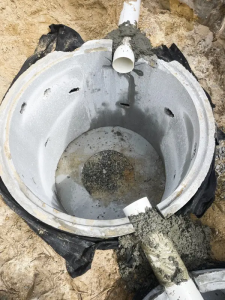Veterinarians are well-respected for the crucial role they play in animal health and wellness. Veterinary medicine is a great career choice for those who have a passion for science and want to make a difference in the world.

A typical day for a veterinarian involves performing animal examinations, including blood work and X-rays. They also treat animals through medications and surgery. Veterinarians often work with other professionals in zoos, wildlife centers and research institutions. Contact Vets In Lapeer, MI for professional help.
Veterinarians don’t just treat sick pets, they also help keep pets healthy by performing routine checkups. These include listening to your pet’s heart and lungs with a stethoscope, measuring their weight, and testing their blood for signs of illness. By doing this regularly, your veterinarian can catch health problems before they become severe. This is especially important for illnesses that start asymptomatically, or without any noticeable symptoms. Early treatment is much more effective, and can save your pet’s life.
Aside from routine health checkups, veterinarians also administer vaccinations to prevent the spread of disease. They’re also skilled surgeons, performing procedures such as spaying and neutering, as well as surgery to remove tumors or foreign bodies from animals. Additionally, they offer advice on diet and behavior to ensure your pet lives a long, happy, and healthy life.
Vaccinations help to prevent diseases that can be deadly to pets and people alike. Veterinarians will often recommend vaccines for their patients, based on the animal’s age and risk factors. Additionally, they will often perform regular fecal tests to ensure your pet is protected from intestinal parasites.
In addition to treating domestic animals, vets also work with wildlife. They might work in zoos, or may travel to farms to make sure the cows, pigs, chickens, and other farm animals are healthy. Veterinarians also help protect the food supply by ensuring that meat products meet strict health standards.
Many people choose to become veterinarians because they love working with animals. However, a career in the field requires more than just a passion for animals; it takes a lot of hard work and dedication. Veterinarians must take courses in subjects such as biology, chemistry, and physics to obtain the knowledge needed to treat animals. Moreover, they must pass challenging exams that require them to think critically about the causes and treatments of different diseases. Finally, they must be prepared to euthanize sick animals in a way that respects their dignity. While the job is rewarding, it can be very stressful and emotional at times. In order to prevent burnout, it is important for veterinarians to set boundaries between their personal and professional lives, and to take time off when necessary.
They Help Keep You Healthy
Veterinarians spend long hours in close contact with multiple clients a day (and often several clients in an hour). They also routinely miss valuable hours of sleep. Their ability to blast through their grueling schedule while remaining clear-headed and sharp in practice is truly remarkable. This is especially impressive considering that they must deal with the stress of zoonotic pathogens that can be found both outside and inside the practice, which increases their risk for illness.
In addition to treating sick animals, veterinarians also work to keep people healthy. They do this in a variety of ways, some obvious and others less so. For example, many vets work on farms to make sure that the cows, pigs and chickens they use to produce food meet strict health standards. This helps ensure that people can eat safe milk and meat without getting sick. Other vets might work at zoos to help treat injured wild animals and ensure that the animals are healthy.
It’s important for people to see their vet regularly. This can help them catch health issues before they become serious and allow them to get treatment early, which is usually more effective and cheaper. Regular vet appointments can also help people with behavioral problems, like house-breaking or separation anxiety, find out if the problem is caused by an underlying health condition that can be treated.
Moreover, some veterinarians focus on research to develop new medicines, vaccines and other tools that can keep pets and people healthy. This is known as veterinary public health, and it’s an essential aspect of animal care. It can be disorienting to consider that veterinarians support human health in so many different ways, but it’s true.
All of this makes for a very diverse career for veterinarians. They might be a cardiologist one moment and a surgeon the next, or even a neurologist for a single patient. This diversity keeps veterinarians interested and excited about their jobs. It also gives them considerable job security as the demand for their services continues to rise. This is one of the many reasons why a career as a veterinarian is a great choice for people who want to make a difference in the world and improve animal care.
They Help Keep Your Dog Healthy
Veterinarians are a big part of the health and well-being of our dogs. They treat animals when they are sick or injured and can help prevent diseases in the first place with routine checkups and vaccinations.
The veterinarian can give you the best advice on nutrition, exercise, grooming, training and behavior management for your pet. They can also give you information about your dog’s environment, such as potential toxins inside or outside the home and what to do if they chew or eat something they shouldn’t.
During a regular visit, the veterinarian can weigh and measure your pet and listen to their heart and lungs with a stethoscope. They will look for any abnormal lumps or bumps, skin issues, signs of pain and discomfort, and other health problems. They can also provide a fecal sample to test for parasites. Many illnesses don’t show any symptoms until they are serious so keeping up with routine visits will help catch these early and keep your pet healthy.
Just like in human medicine, there are specialties for veterinarians. Some focus on internal medicine, surgery, dermatology, and others work in emergency or public health. They can also advise government officials on zoonotic diseases, or those that can be transferred between animals and humans.
Veterinarians can perform surgeries to remove foreign objects from your dog’s body, such as a clogged drain or a broken bone. They can also provide a variety of vaccines to protect your pet from deadly diseases, including rabies and distemper. They can also treat fleas, ticks, and other parasites to keep your pet free of these harmful organisms that can cause a wide range of health issues.
Just as important, the vet can help you keep your pet at a healthy weight and diet. They can make recommendations on how much to feed your dog or cat based on their age, size, and lifestyle. This will keep your pet from becoming overweight which can lead to numerous health issues, like arthritis and diabetes. They can also recommend a proper dental care routine to keep your pet’s teeth and gums healthy.
They Help Keep Your Cat Healthy
Vets are trained to spot the signs of an issue, like a lump on a paw or dental tartar. They can also help keep cats healthy by providing vaccinations, parasite control and other preventive measures tailored to each cat’s lifestyle and health needs. These services can save pet owners money in the long run by preventing future health issues and discomforts, such as diabetes and obesity.
Regular checkups also give veterinarians the opportunity to educate pet owners on important topics like proper nutrition and weight management, spaying/neutering, and the importance of routine care. Pets can be good at hiding discomfort and other health issues, so it’s up to pet owners to make sure their cats are healthy, especially since the early signs of most conditions don’t become obvious until they have reached an advanced stage.
A routine veterinary exam includes a head-to-tail physical examination, including checking eyes, ears, mouth and teeth, listening to the heart and lungs, palpating the abdomen, and more. It’s during these appointments that vets can spot an issue before it becomes serious. For example, a small lesion on the skin can indicate an infection that is easily treated with antibiotics, but without treatment may become much more severe. Similarly, dental disease is common in cats and can cause serious problems if left untreated. Regular veterinary exams allow vets to spot early signs of dental disease, and recommend professional cleanings and home care to keep cats’ oral health in tip-top shape.
In addition to preventive health care, vets can also perform necessary procedures like deworming and rabies shots to protect against infectious diseases. They can also prescribe medication to treat health issues like arthritis, allergies, and thyroid disease. They can also provide advice and education for pet owners on important issues such as grooming, protecting pets from household hazards, and how to introduce new animals into the household.
As mentioned, vets can even perform surgery on sick animals. This can include removing a tumor, fixing broken bones, or taking out an object that has been swallowed. Veterinarians are specially trained to do these operations safely.

